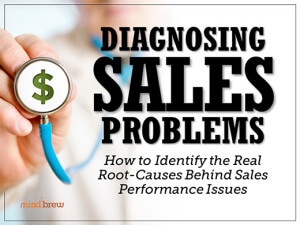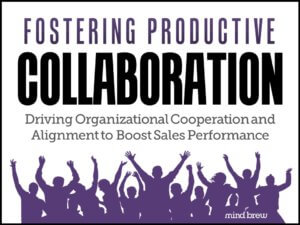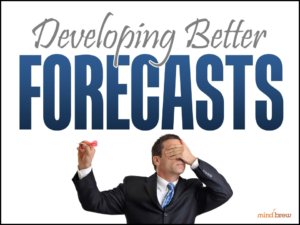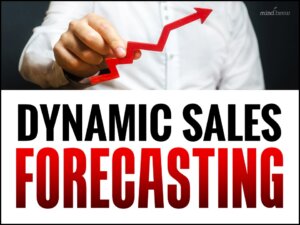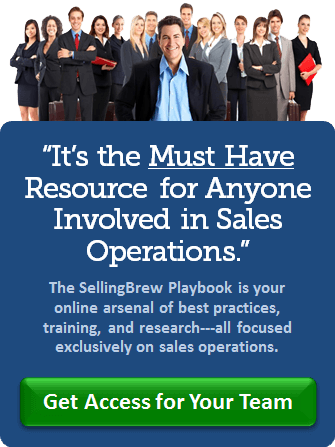In business, just like in medicine, the treatment you prescribe is only effective if it’s based on the right diagnosis.
For example, imagine that you go to the doctor because you’ve been having chronic headaches. If the physician believes that your headaches are caused by sinus pressure due to allergies, they might recommend some over-the-counter decongestant and antihistamines and send you on your way.
But if you actually have a brain tumor, those medications aren’t going to do any good. Even worse, wasting time on this ineffective treatment will give the tumor time to grow even larger, potentially putting your life at risk.
Sales organizations often fall into a similar trap when diagnosing performance problems. A slowdown in revenue triggers a reaction, but if the wrong conclusion is reached, the “solution” can make things worse.
- Misreading Sales Signals: Just like the doctor in our example, sales teams often jump to conclusions about what’s causing a revenue dip.
For instance, if sales decline, leadership might assume that pricing is the issue and demand across-the-board discounts. But if the real problem is an emerging competitor with a better onboarding experience, those price cuts won’t help. Instead, they’ll damage margins while failing to fix the true issue. A better response would have been streamlining the buying process and reinforcing value messaging. - Misunderstanding Sales Productivity: When deal closures slow down, sales leadership often assumes that reps aren’t making enough calls or sending enough emails. The knee-jerk reaction? Mandate higher activity targets. But what if the real issue isn’t effort, but inefficiency? Maybe the CRM is cluttered with outdated data, making it hard for reps to prioritize the right accounts. Or perhaps long internal approval cycles are delaying deals. Instead of adding more calls to a broken process, the better solution is to streamline workflows, clean up account data, or reduce unnecessary bottlenecks.
- Misidentifying Forecasting Failures: When revenue projections are way off, executives often assume that the sales team failed at forecasting. The fix? Push them to be more diligent in updating their pipeline data. But in reality, the real issue could be pipeline bloat—reps are holding onto stalled opportunities because they don’t have a clear process for disqualifying bad deals. Or maybe there’s a disconnect between sales and marketing, leading to low-quality leads being funneled into the pipeline. Instead of demanding better forecasts, the smarter move would be improving deal qualification criteria and lead scoring models.
How to Improve Your Sales Diagnosis
The key to avoiding misdiagnoses is to step back and challenge assumptions. Here’s how:
- Dig for Real Root Causes: Don’t settle for the first explanation. Dig into your data and ask, What else could be happening? Running detailed win/loss analyses or customer feedback studies can help prevent knee-jerk reactions. The webinar on Diagnosing Sales Problems can help.
- Collaborate Cross-Functionally: The best diagnoses come from multiple perspectives. A doctor consulting a specialist may reach a better conclusion. Likewise, Sales Ops teams that engage with sales, marketing, and customer success will get a clearer picture of what’s actually driving performance trends.
We cover this idea in more detail in Fostering Productive Collaboration. - Test Before You Treat: A good doctor wouldn’t prescribe aggressive treatment without confirming the diagnosis. The same goes for sales changes. Instead of rolling out sweeping policy shifts, test hypotheses through pilot programs or A/B sales experiments to ensure you’re solving the real issue. We explain how in Successful Sales Ops Pilot Programs.
- Improve with Data, Not Gut Feel: Relying on sales reps’ gut feel and estimates often leads to faulty conclusions–especially with forecasts. Leading Sales Ops teams turn to data-driven models, frequent updates, and clear distinctions between forecasts and sales targets to improve accuracy. We discuss more in Developing Better Forecasts.
No doctor gets every diagnosis right 100% of the time. And you likely are going to make a few mistakes now and then in determining the root cause of your sales problems.
However, by consistently going through these steps, you will improve your odds of getting it right, ultimately resulting in a healthier company.

